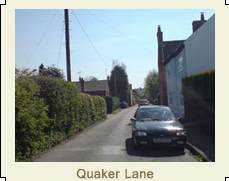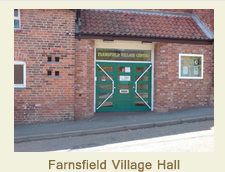A Brief History of Farnsfield Village
The first record of the village is in 956 AD when it was called Fernefeld. Within the village itself there are no records of any earlier occupation but a short way to the south lies an Iron Age fort and at Hexgreave Park, just to the north of the village, and at Coombs Farm, just to the south, Iron Age implements dating to 1000 BC have been found. There is also evidence on the edge of the village and at Hexgreave Park of Roman occupation.
In the Domesday Book the village is referred to as Franesfeld and is stated to be owned by Walter D’Ayncourt. By the twelfth century the village’s name had become established as Farnsfield. As to its meaning there are two schools of thought – one states it means “Fields of Fern”, the other that it was a “clearing with ferns in the forest”. Certainly up to 1600 and probably beyond, the village was within the boundary of Sherwood Forest and was subject to Forest Laws. Gradually encroachments into the forest, then the Enclosure Act Award of 1777 pushed the forest boundary back and Farnsfield came to lie outside the boundaries of the forest.
The present church is quite young, having been built in 1859/60 to replace the earlier church which was destroyed by fire in 1856. It was rumoured, but never proved, that the fire was started by one of the churchwardens as a result of a dispute with the other warden. From the point of view of the local historian the fire was a disaster as it destroyed many of the earlier church records. We do know however that the village did not have its own vicar until 1572. Before that its spiritual needs were attended to by the canons of Southwell Minster.
Quaker Lane
 One aspect of religion for which the village has wider recognition is Quakerism in its early days, the village having many more Quaker residents for its size than many larger villages and towns. One street is called Quaker Lane and there are numerous Quaker built houses within the village.
One aspect of religion for which the village has wider recognition is Quakerism in its early days, the village having many more Quaker residents for its size than many larger villages and towns. One street is called Quaker Lane and there are numerous Quaker built houses within the village.
As previously stated, the village doess not have any major industry but in former times small businesses were located within the village, mainly related to agriculture and rural trades – blacksmiths, tanners, basketmakers. There was also a flourishing brickmaking works on Brickyard Lane which utilised the local clay and produced quite a distinctive red brick of a smaller size than modern bricks and which can be seen on many of the older cottages in the village. Clay was also used by the local pottery which made tiles, drinking vessels and other domestic items.
Village Hall

A building in the village of particular interest is the Old Maltings on New Hill, now refurbished and converted for use as a Village Centre and used by clubs and societies, individuals and outside organisations for meetings and events.
There was for a brief period a cotton mill at “Cotton Mill Farm” utilising the water of the stream that ran through the farm. It is believed, but has never been proved, that the mill was one of the small cotton mills designed by Sir Richard Arkwright, the progenitor of the Industrial Revolution.
Farnsfield, like the majority of similar villages, does not feature in any great national historical events. Some important members of the village were involved in a local secret society “The Sealed Knot” in an unsuccessful conspiracy against Oliver Cromwell and his “Major Generals”.
The village’s most famous son was Sir Augustus Gregory who went with his family to Australia in the early 19th century and became a famous explorer, credited with leading successful expeditions into the interior. (For further information see his designated page under the heading “People”.)
Postman
 There is also a totally untrue legend that George III set up Lady Gertrude Saville as his mistress and had Burgess House built for her. However, Lady Saville did keep a detailed diary covering her period in the village which throws some light on life here from 1737-1743.
There is also a totally untrue legend that George III set up Lady Gertrude Saville as his mistress and had Burgess House built for her. However, Lady Saville did keep a detailed diary covering her period in the village which throws some light on life here from 1737-1743.
Between 1834 and 1866 Farnsfield was noted for having as its postman George Yates who was blind. Every day he walked from Farnsfield to Southwell with the outgoing post and then returned with letters for the villagers. It is recorded he was never absent or late.
During the Second World War the low hill just to the south of the village was the scene of tragedy when a Halifax Bomber stationed at a Yorkshire airfield got into difficulties and crashed on the hill killing the entire crew, some Canadian, some British.
A permanent memorial has been erected on the site of the crash near Riddings Farm. The memorial is maintained by the village and can be visited. In addition several new roads in the village have been named after crew members.